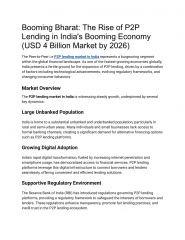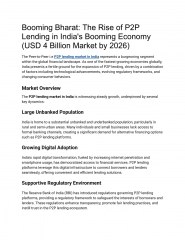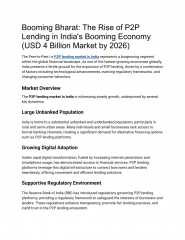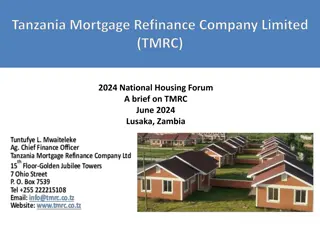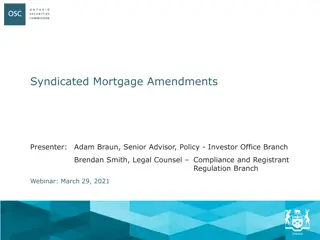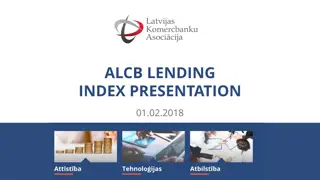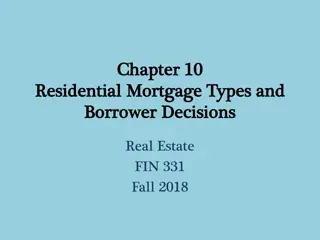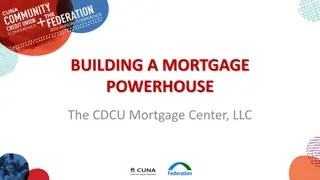
Evolution of Mortgage Valuations in Banking Sector
Explore the evolution of mortgage valuations in the banking sector, from government involvement to privatization of valuation services. Learn about the transition from employee valuers to contractors and the necessity of valuations for mortgage lending.
Uploaded on | 0 Views
Download Presentation

Please find below an Image/Link to download the presentation.
The content on the website is provided AS IS for your information and personal use only. It may not be sold, licensed, or shared on other websites without obtaining consent from the author. If you encounter any issues during the download, it is possible that the publisher has removed the file from their server.
You are allowed to download the files provided on this website for personal or commercial use, subject to the condition that they are used lawfully. All files are the property of their respective owners.
The content on the website is provided AS IS for your information and personal use only. It may not be sold, licensed, or shared on other websites without obtaining consent from the author.
E N D
Presentation Transcript
Evolution of valuations for mortgage lending purposes 22ndPacific-Rim Real Estate Conference University of the Sunshine Coast 17-20 January 2016 Vince Mangioni University of Technology Sydney
Paper objectives Examines the evolution of the banking sector and purpose of mortgage valuations . Cases have been reviewed that have presumably endorsed the purchase price of property as the best evidence of value, subject to meeting the Spencer Test. Define the valuers role and examine the practices in undertaking mortgage valuations.
Exit of government from banking since the 1990s The Banking sector has progressively privatised following the recommendations of the Campbell inquiry of the late 1980s The Commonwealth Government progressively privatised the Commonwealth Bank, with an initial public offering in 1991, and a subsequent float of the remaining equity in July 1996. State governments have also sold or privatised State financial institutions, including: in 1991 the Victorian Government sold the State Bank of Victoria to the Commonwealth Bank; NSW Government in December 1994, sold the State Bank of NSW to Colonial Mutual Life; and, 1995, the South Australian Government sold the State Bank of South Australia to Advance Bank.
Privatisation of valuation services Following the sell off and privatisation of the banks by government a number of services and sector have privatised which include valuation services. Where valuers were prior to privatisation employed directly by the banks, since the early to mid 1990s valuation services are tendered out resulting in many valuers transitioning from employee to contractor.
Privatisation of valuation services In the case of mortgage valuation work, many of the employees of lending institutions set up practice and began contracting valuation services back to lenders from the early 1990s. This was seen as a way of creating market efficiency in the cost of valuation services, in addition to the perceived benefits of creating a regulator and operator relationship.
Why are valuations for mortgage lending necessary All assets taken as security by approved deposit taking institutions (ADI s) should be valued, wherever possible, at their net current market value (Australian Prudential Regulation Authority, 2000:1)
Transfer of risk In reality, the valuation provided by the valuer to the lender constitutes an effectively allows the mortgage insurer to insure the loan and cover the lenders loss and recover a loss from the valuer for over valuation. insurance policy, which Borrower Defaults Lender incurs loss and calls on its loss Loan Insurer pays the loss and recovers from the valuer Valuer recovers the loss from their insurer Valuers Insurer
Valuation fee as a percentage of the mortgage insurance Property Value $500,000 $500,000 $500,000 Loan Amt as % of property value 81% 85% 90% Mortgage Insurance $2246 $4505 $6660 Valuation Fee $220 $220 $220 Valuation as a % of Insurance 10 5 3.3
Survey process Surveys were distributed to 110 valuers in medium to large valuation practices across Sydney and New South Wales by post, with 43 surveys returned. The survey addressed purpose, risk, evidence and information sources that valuers rely on in undertaking valuations for mortgage lending. questions about
Valuation purposes Purpose Mortgage Transfer / Capital Gains Tax Family Court Buy or sell advice Objections & Acquisitions Other % of valuation work 38 22 16 14 4 6
Risk rating of mortgage valuations by valuerson a scale of 1-10 Valuation sub-purpose Median Risk Rating Average Risk Rating Sale over the subject property plus several current comparable sales Refinancing of a property and no sale over the subject but several comparable sales A sale of the subject property and no comparable sales evidence Refinance with no sale over the subject property and no comparable sales 2 2.3 3.5 3.4 5 5.4 7.5 7.6
Number of sales used to confirm value Minimum sales 3 4 5 6 or more Number of valuers 12 16 8 7 Median years experience 10 20 10 30
Sources of sales data Source RP Data Agents Red Square Aust Prop Monitors Realestate.com Other Total No of valuers 25 6 6 3 2 1 43 % of valuers 58 14 14 7 4.7 2.3 100%
Is property transaction data available in an acceptable timeframe Yes 11 25.6 No 32 74.4 No of responses Percentage Sales data and information Information No of bedrooms Area of the dwelling % of valuers 80 50 Additional data sought = floor plan & living area size / orientation
How often are you contacted by a lender when your valuation is lower than the purchase price 86 per cent of the time Lending institutions will generally lend on the lower of either the purchase price or valuation
Emerging practices of residential / mortgage valuers Houses Reviewing development application registers at local government for recent alternations and additions. Strata Title Use of income (capitalization) method of analysis where property is held by investors and are subject to leases. $m2 of sale price Sale price / internal area as per strata plan Holding periods Units and houses within suburbs / locations over the past 10-15 years changes in frequency of turnover.
Conclusion Banking sector has progressively privatised and government has moved away from ownership of banks. Valuers have moved from being employed to contracting for mortgage lending purposes with mortgage valuation being the dominant valuation purpose. Valuers practices are evolving in mortgage valuations and they are seeking more detailed information and in a more timely delivery. A hiatus has developed in the training of valuers over the past 20 years with outsourcing of valuations by government agencies.

